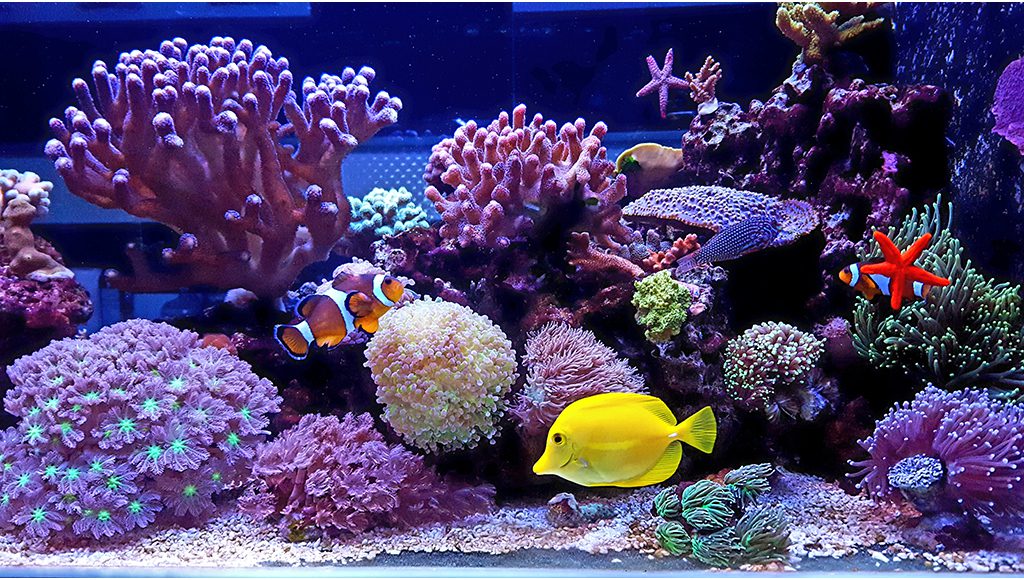Creating a Large Saltwater Aquarium
It Feels Like Home!

Creating a Large Saltwater Aquarium: A How To Guide.
Creating a large saltwater aquarium with a vibrant collection of tropical fish can be a rewarding and visually stunning addition to your home. This guide will take you through the essential steps, from planning and setting up your aquarium to maintaining a healthy environment for your tropical fish.
Planning and Preparation
Research and Planning:
- Budget: Determine your budget for the aquarium, including the tank, equipment, fish, and ongoing maintenance costs.
- Space: Choose a suitable location in your home that can support the weight of a large aquarium (1 gallon of water weighs approximately 8.34 pounds).
- Tank Size: Larger tanks (75-150 gallons) are more stable and easier to maintain than smaller tanks.
Choosing Your Fish:
- Tropical Fish Selection: Research the types of tropical fish you want to keep, ensuring they are compatible in terms of temperament, size, and water requirements.
- Community Tank: Consider creating a community tank with a variety of fish, invertebrates, and corals that can coexist peacefully.
Equipment Needed
Aquarium Tank:
- Size and Shape: Choose a tank size that fits your space and budget. Rectangular tanks are most common and provide good surface area for gas exchange.
Filtration System:
- Protein Skimmer: Removes organic waste from the water before it breaks down, improving water quality.
- Mechanical, Chemical, and Biological Filtration: Use a combination of these filtration methods to keep the water clean and safe for your fish.
Lighting:
- LED Lights: Provide energy-efficient and customizable lighting. Ensure the lights support both fish and coral needs if you plan to keep corals.
- Lighting Schedule: Mimic natural light cycles to help maintain fish health and support coral growth.
Heating:
- Aquarium Heater: Maintain a stable water temperature between 75-80°F (24-27°C), which is ideal for most tropical fish.
- Thermometer: Monitor the water temperature regularly.
Water Movement:
- Powerheads and Wave Makers: Create water movement to replicate natural ocean currents, promoting gas exchange and preventing debris buildup.
- Sump and Return Pump: Enhance filtration and water movement, providing additional water volume and a place to house equipment.
Substrate and Live Rock:
- Live Sand: Provides beneficial bacteria that help with biological filtration.
- Live Rock: Acts as a natural biological filter, offering hiding places for fish and a surface for beneficial organisms.
Water Testing Kits:
- Ammonia, Nitrite, Nitrate, pH, and Salinity: Regularly test these parameters to maintain optimal water conditions.
Setting Up Your Aquarium
Tank Placement:
- Place the tank on a sturdy, level stand designed to support its weight.
- Avoid placing the tank near windows or heat sources to prevent temperature fluctuations and algae growth.
Cleaning and Assembly:
- Rinse the tank, substrate, and equipment with freshwater before assembly (do not use soap).
- Install the filtration system, heaters, powerheads, and lighting according to the manufacturer’s instructions.
Adding Water:
- Saltwater Mix: Use a high-quality marine salt mix to prepare your saltwater. Follow the instructions to achieve the correct salinity (specific gravity of 1.023-1.025).
- Filling the Tank: Fill the tank with saltwater and turn on the filtration system, heater, and powerheads. Allow the water to circulate and stabilize.
Cycling the Tank:
- Nitrogen Cycle: Start the nitrogen cycle by adding a source of ammonia (like fish food or a commercial product). This process can take 4-6 weeks.
- Monitoring: Regularly test the water for ammonia, nitrite, and nitrate levels. Once ammonia and nitrite levels drop to zero and nitrates are low, the tank is cycled.
Adding Fish and Invertebrates
Acclimation:
- Drip Acclimation: Slowly introduce new fish to the tank water to minimize stress. Drip acclimate them by gradually mixing tank water into the bag or container holding the fish over a period of 1-2 hours.
Stocking Your Tank:
- Adding Fish Gradually: Start with a few hardy fish and gradually add more over several weeks to avoid overloading the biological filtration.
- Compatibility: Ensure the new fish are compatible with the existing tank inhabitants.
Invertebrates and Corals:
- Coral Placement: If keeping corals, place them in appropriate lighting and water flow conditions based on their species requirements.
- Invertebrates: Add beneficial invertebrates like snails, crabs, and shrimp to help keep the tank clean.
Maintenance and Care
Regular Maintenance:
- Water Changes: Perform regular water changes (10-20% every 1-2 weeks) to remove waste and replenish essential minerals.
- Testing Water Parameters: Continuously monitor water quality and adjust as needed.
- Cleaning: Clean the glass, substrate, and equipment to prevent algae buildup and maintain a healthy environment.
Feeding:
- Balanced Diet: Provide a varied diet suitable for your fish species. Include high-quality pellets, flakes, frozen, and live foods.
- Feeding Schedule: Feed small amounts 1-2 times a day, ensuring all food is consumed within a few minutes to avoid overfeeding.
Troubleshooting and Health
Monitoring Health:
- Behavior and Appearance: Regularly observe your fish for signs of stress, disease, or unusual behavior.
- Quarantine Tank: Use a separate quarantine tank to isolate and treat any sick fish before reintroducing them to the main tank.
Common Issues:
- Algae Blooms: Manage algae by controlling lighting, nutrient levels, and using algae-eating invertebrates.
- Disease: Identify and treat common fish diseases promptly to prevent outbreaks.
Setting up and maintaining a large saltwater aquarium with tropical fish is a fulfilling hobby that brings a piece of the ocean into your home. By carefully planning your setup, choosing the right equipment, and maintaining a healthy environment, you can enjoy a beautiful and thriving marine ecosystem. Regular maintenance and attentive care will ensure your aquarium remains a stunning centerpiece for years to come. Happy fishkeeping!
